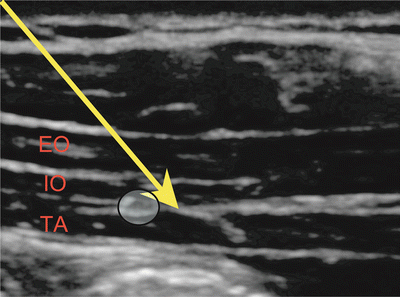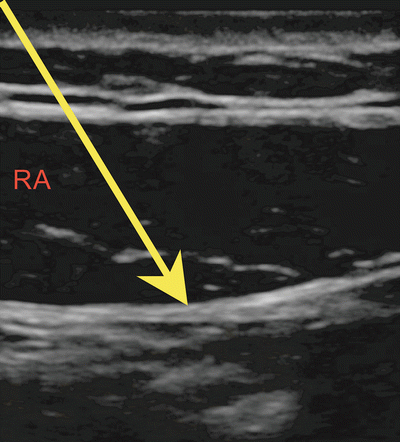Fig. 12.1
Arrow indicating potential space where local anesthetic is deposited (EO external oblique, IO internal oblique, TA transversus abdominis muscle)
Technique
Various techniques have been described to use an in-plane approach with ultrasound guidance that allows needle advancement and placement of local anesthetic into the TAP [10, 11]. A high-frequency linear probe is placed lateral to the umbilicus and moved laterally to demarcate the three muscle layers of the abdominal wall. The needle is advanced using an in-plane technique to the space between the internal oblique and the transversus abdominis. Injection, with incremental aspiration, will create an elliptical pocket of local anesthetic into the space where the nerves traverse.
Complications
TAP blocks are easily performed in the outpatient setting. Potential complications include intravascular injection and peritoneal and/or bowel puncture. These complications are minimized with the use of ultrasound guidance.
Ilioinguinal/Iliohypogastric (IL/IH) Nerve Block
Anatomy and Indications
The ilioinguinal nerve, which provides sensation to the groin area, can be blocked for therapeutic purposes in patients suffering from chronic pain after previous surgical procedures in the inguinal region. Ilioinguinal neuralgia following hernia repair is an underreported cause of abdominal pain in older children and adolescents [12] and is likely secondary to major nerve dissection during surgery. We have demonstrated the efficacy of performing serial ilioinguinal nerve blocks in adolescents with persistent groin pain following inguinal hernia repair [13]. For cases of refractory pain, we have placed a continuous infusion catheter in this space with good results.
The ilioinguinal/iliohypogastric (IL/IH) nerves originate from T12 and L1 of the thoracolumbar plexus. The nerves traverse the internal oblique aponeurosis just medial to the anterior superior iliac spine (ASIS). IL/IH nerve blocks provide analgesia to the inguinal region and anterior scrotum [14]. Successful placement of these blocks results in equivocal pain relief as provided by caudal blocks for inguinal procedures [15, 16].
Technique
A linear ultrasound probe is placed at the ASIS, in line with the umbilicus. The three abdominal muscle layers are identified (internal oblique, external oblique, and transversus abdominis), although at this level the external oblique muscle layer may be aponeurotic (Fig. 12.2). The inguinal nerve may appear as an ovular structure between the internal oblique and transverse abdominal muscles. The needle is inserted in plane from a lateral to medial approach with incremental needle repositioning. The volume of local anesthetic solution required to block conduction of both nerves has been reported as significantly less with the use of ultrasound when compared to landmark-based techniques [17, 18].


Fig. 12.2
Arrow indicating space where local anesthetic injected for ilioinguinal/iliohypogastric nerve block (EO external oblique, IO internal oblique, TA transversus abdominis muscle)
Complications
Bowel puncture and intravascular injection are rare but potentially severe complications. Isolated case reports exist of pelvic hematoma and femoral nerve palsy with performance of II/IH nerve blocks.
Rectus Sheath Block
Anatomy and Indications
Serial rectus sheath blocks have be described as an effective means of providing analgesia for children with chronic abdominal wall pain [19]. This technique is particularly useful for the treatment of periumbilical pain states.
The rectus abdominis muscle lies on the anterior abdominal wall and is separated in the midline by the linea alba. The thoracolumbar nerves (T7–T11) traverse the potential space between the rectus abdominis muscle and posterior rectus sheath. The rectus sheath block is commonly used to achieve periumbilical analgesia for surgical procedures including Single Incision Laparoscopic Surgery (SILS) and umbilical hernia repair [20].
Technique
A linear probe is placed transversely immediately lateral to the umbilicus (Fig. 12.3). The rectus abdominis muscle is visualized as the first major layer beyond the subcutaneous tissue (Fig. 12.4). The posterior sheath lies immediately below the rectus abdominis and sits above the peritoneum. The probe is maintained immediately lateral to the umbilicus. A needle is placed in-plane from the lateral aspect of the probe and local anesthetic is deposited in the potential space between the rectus abdominis muscle and its posterior sheath. Approximately 0.1 ml/kg of local anesthetic is used to provide analgesia [21].



Fig. 12.3
Rectus sheath block performed in a child using an “in-plane” approach

Fig. 12.4



Sonographic image with arrow indicating location for local anesthetic placement for rectus sheath block (RA rectus abdominis muscle)

Full access? Get Clinical Tree






